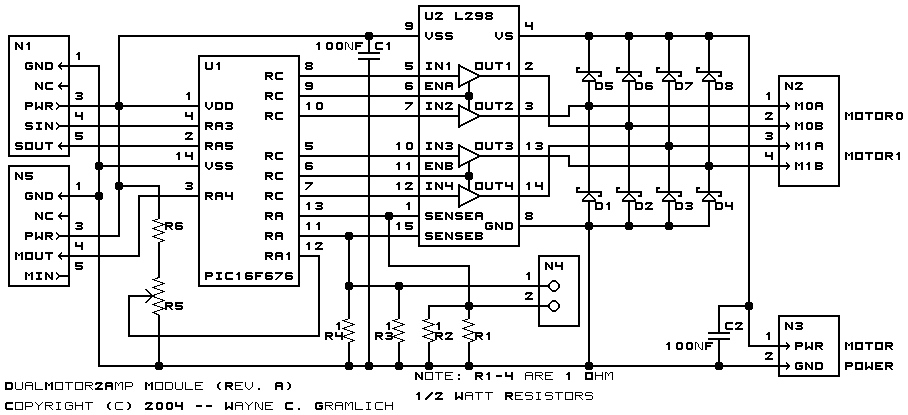This is revision A of the
DualMotor2Amp module. The status of this project is
work in progress.
DualMotor2Amp Module (Revision A)
This document is also available as a
PDF document.
The DualMotor2Amp module allows for control of up to
two small DC motors via pulse width modulation
and up to 2 amps per motor. Power is provided via
an external terminal block.
{To be written}.
The DualMotor2Amp commands are summarized in the table
below:
| Command |
Send/
Receive |
Byte Value |
Discussion |
| 7 |
6 |
5 |
4 |
3 |
2 |
1 |
0 |
| More commands here. |
| Shared Commands |
Send |
1 |
1 |
1 |
1 |
1 |
c |
c |
c |
Execute
shared command ccc. |
On power up, the DualMotor2amp module sets all variables
to zero. The motor modes default to pulsed forward.
The hardware consists of a circuit schematic and
a printed circuit board.
The schematic for the DualMotor2amp module is shown below:

The parts list kept in a separate file --
dualmotor2amp.ptl.
The printed circuit files are listed below:
-
dualmotor2amp_back.png
-
The solder side layer.
-
dualmotor2amp_front.png
-
The component side layer.
-
dualmotor2amp_artwork.png
-
The artwork layer.
-
dualmotor2amp.gbl
-
The RS-274X "Gerber" back (solder side) layer.
-
dualmotor2amp.gtl
-
The RS-274X "Gerber" top (component side) layer.
-
dualmotor2amp.gal
-
The RS-274X "Gerber" artwork layer.
-
dualmotor2amp.drl
-
The "Excellon" NC drill file.
-
dualmotor2amp.tol
-
The "Excellon" NC drill rack file.
The DualMotor2amp software is available as one of:
-
dualmotor2amp.ucl
-
The µCL source file.
-
dualmotor2amp.asm
-
The resulting human readable PIC assembly file.
-
dualmotor2amp.lst
-
The resulting human readable PIC listing file.
-
dualmotor2amp.hex
-
The resulting Intel® Hex file
that can be fed into a PIC12C5xx programmer.
The DualMotor2amp test suite is available as one of:
-
dualmotor2amp_test.ucl
-
The µCL source file.
-
dualmotor2amp_test.asm
-
The resulting human readable PIC assembly file.
-
dualmotor2amp_test.lst
-
The resulting human readable PIC listing file.
-
dualmotor2amp_test.hex
-
The resulting Intel® Hex file
that can be fed into a PIC16F84 programmer.
The following issues need to be considered:
-
Consider using the TI 754410 instead of the LM293.
Copyright (c) 2000-2003 by
Wayne C. Gramlich.
All rights reserved.
